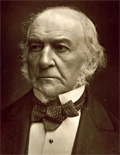 |
William Ewart Gladstoneb. 29 Dec 1809, Liverpool |
| Ministerial offices: | Junior Lord of the Treasury (26 Dec 1834 - 27 Jan 1835) |
| Under Secretary for the Colonies (27 Jan 1835 - 8 Apr 1835) | |
| Vice-President of the Board of Trade (3 Sep 1841 - 15 May 1843) | |
| President of the Board of Trade (15 May 1843 - 3 Feb 1845) | |
| Colonial Secretary (23 Dec 1845 - 27 Jun 1846) | |
| Chancellor of the Exchequer (28 Dec 1852 - 22 Feb 1855, 18 Jun 1859 - 26 Jun 1866, 30 Aug 1873 - 17 Feb 1874, 28 Apr 1880 - 16 Dec 1882) | |
| Leader of the House of Commons (29 Oct 1865 - 26 Jun 1866) | |
| First Lord of the Treasury and Leader of the House of Commons (3 Dec 1868 - 17 Feb 1874, 23 Apr 1880 - 9 Jun 1885, 1 Feb 1886 - 20 Jul 1886, 15 Aug 1892 - 2 Mar 1894) | |
| Lord Privy Seal (17 Feb 1886 - 20 Jul 1886, 20 Aug 1892 - 2 Mar 1894) |
| Biography: | |
The son of a Scottish trader and owner of sugar plantations, William Gladstone studied at Eton and Christ Church College, Oxford, where he received his degree in Classics and mathematics. He was returned as MP for the first time in December 1832 (MP, 1832-1895). Gladstone was President of the Board of Trade (1843-1845) under Sir Robert Peel and Chancellor of the Exchequer (1852-1855) under the Earl of Aberdeen and again (1859-1866) under Viscount Palmerston and Earl Russell, contributing significantly to the development of this office. Initially a Conservative MP, Gladstone turned to Liberals and became Leader of the Liberal Party (1865-1875). Following the Liberal victory at the 1868 General Election (Liberal 387, Conservative 271) Benjamin Disraeli resigned and Queen Victoria called on Gladstone to form a government. He was appointed First Lord of the Treasury on 3 Dec 1868. His first administration passed an Act to disestablish the Church of Ireland (26 Jul 1869) and his first Irish Land Act (Aug 1870), but he was defeated on the Irish University Bill, proposing a new university at Dublin open to both Catholics and Protestants. As a result, Gladstone resigned (13 Mar 1873) but was forced back into office by Disraeli's refusal to form a minority government. In August 1873 he reshuffled the Cabinet and again took on the chancellorship of the Exchequer himself (1873-1874). He dissolved Parliament in January 1874, but his party was heavily defeated (Conservative 350, Liberal 242) and Gladstone resigned (17 Feb 1874). He also retired as Leader of the Liberal Party in favor of Lord Hartington. After the victory of Liberals at the 1880 General Election (Liberal 352, Conservative 237) the Queen, who personally disliked Gladstone, asked Lord Hartington to form a Government (22 Apr 1880), but the latter persuaded her to send for Gladstone, who was again appointed First Lord of the Treasury (23 Apr 1880) and assumed the chancellorship of the Exchequer (1880-1882). Gladstone was also restored as Leader of the Liberal Party (1880-1894). Under his second administration an Act was passed to strengthen the coercion powers of the Irish Viceroy (Feb 1881), together with a second Irish Land Act (22 Aug 1881). He extended the franchise, but overseas, the revolt in Sudan led to the loss of British control and the death of General Gordon at Khartoum (Jan 1885). When the 1885 Budget was defeated, Gladstone resigned (9 Jun 1885). The Queen offered Gladstone an earldom, which he declined. In January 1886 Gladstone and the Irish Nationalists joined forces and defeated the Salisbury's Government. Gladstone was made First Lord of the Treasury (1 Feb 1886), combining it with the office of Lord Privy Seal (1886). During this short administration Gladstone introduced an Irish Home Rule Bill (8 Apr 1886), which was debated for 16 days and was defeated on 8 Jun 1886. Gladstone asked the Queen to dissolve Parliament, but the Conservatives were victorious at the 1886 General Election (Conservative 393, Liberal 192, others 85), and Gladstone resigned his offices on 20 Jul 1886. The 1892 General Election returned no overall majority (Liberal 272, Conservative 313, others 85), but when Marquess of Salisbury resigned after a vote of no confidence Gladstone was appointed First Lord of the Treasury (15 Aug 1892), again combining it with the office of Lord Privy Seal (1892-1894). The fall of Parnell, leader of the Irish Home Rule Party, was a serious blow, but Gladstone introduced another Home Rule Bill, which was rejected in the Lords (8 Sep 1893) by the largest majority ever recorded there to that time, 419-41. Gladstone refused to accept Naval estimates and, finding himself isolated in the Cabinet, resigned on 2 Mar 1894. [1, pp. 195-204] |
|
| | |
| [1] | Englefield, Dermot; Seaton, Janet; White, Isobel (eds.) Facts About the British Prime Ministers: A Compilation of Biographical and Historical Information. New York: The H.W. Wilson Company, 1995. online |
| Image: photograph of William E. Gladstone, c. 1880. | |
